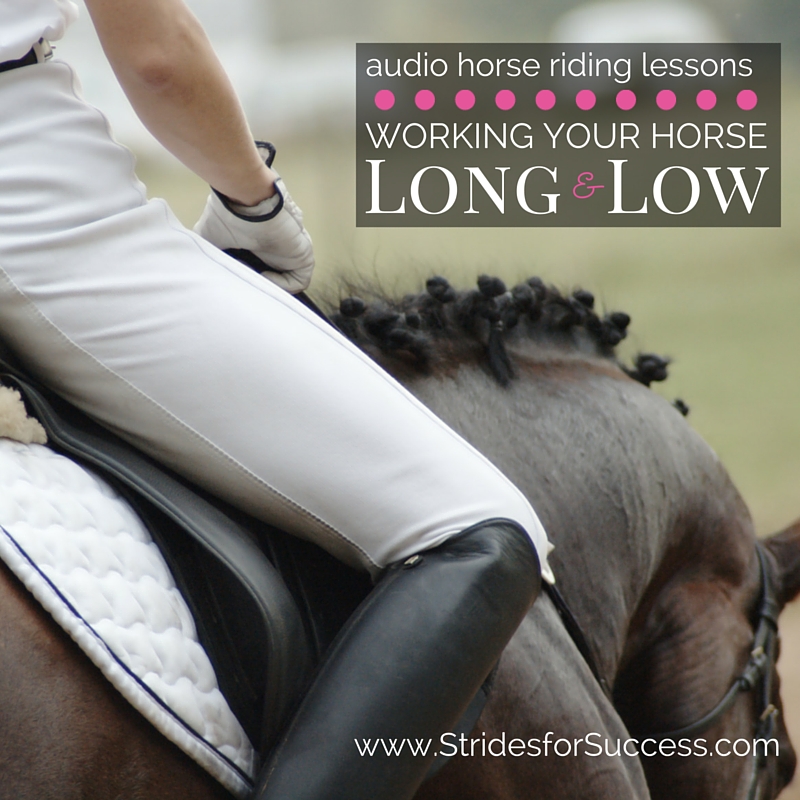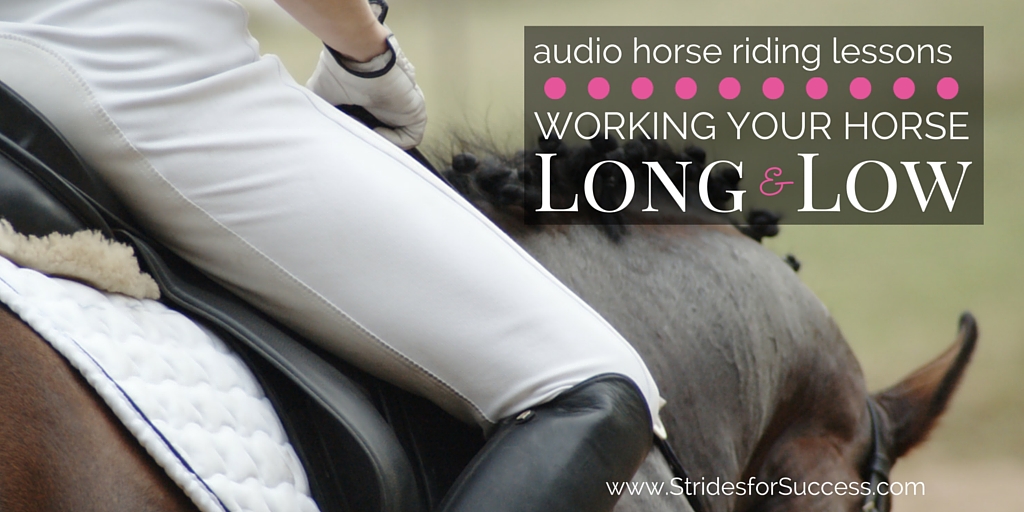So often when we are riding, relaxation for both ourselves and our horse is one of the goals for the ride. This being so, you may have tried working him long and low. And probably during warming up or cooling off.
However, you may also have noticed that asking your horse to work long and low can be pretty hit and miss… He might get faster and faster as he becomes really unbalanced and begins falling onto his forehand…
What is Long and Low?
Working your horse long and low involves stretching and elongating his topline, from the tail to the poll.
It helps to build his topline, strengthening the ‘suspension’ muscles underneath you and also, create more longitudinal suppleness, which will benefit your horse greatly while being ridden. So often when riding we think of suppleness as bending and flexing from left to right and while this is true, this is lateral suppleness.
Working your horse long and low helps with his elasticity and flexibility from tail to poll, along his back, which is essential to his correct development.

Increasing Flexion with Long & Low
When riding your horse in a long and low frame, you will feel his hindquarters swinging underneath you. This is due to the muscles in his back becoming more supple and loosening up. This can only happen when your horse relaxes enough through is back, allowing the energy to flow and connect.
This results in your horse developing an increased range of flexion and movement in his joints, which will allow for a bigger, more flowing, step or stride. And a more sound horse!
Your horse should remain balanced, in rhythm and have a consistent forward movement while he is working in the long and low way, whether in walk, trot or canter
Riding ‘the Rainbow’
When you are correctly working long and low, think of your horse’s back as being a rainbow. And you’re perched on the top of that rainbow! And just like with a rainbow where the ‘colour stripes’ begin at one end and follow through right to the other end, your horse’s energy should do the same.
From the hindquarters, right through the back and to the contact with your hand in front.
First Forwardness…
First and foremost, there must be forward energy or impulsion happening in the gait. This must come from the horse’s hindquarters coming in underneath him and ‘pushing’ off with each step. It is also vitally important to maintain contact with your horse’s mouth.
As your horse reaches forward and stretches down, your hands must follow. Otherwise, you restrict him and may cause him to lean and get on his forehand.
Your job is to help keep the impulsion and the contact consistent while the horse is working long and low, all the while being light in the saddle. This is so his back can rise up and almost ‘arch’ underneath you.
However, often riders do not understand the mechanics behind this frame and this generally results in a few different ‘variations’ of the movement. A lot of these ‘variations’ will result in your horse failing to maintain the balance, rhythm and forwardness that is required.
Front-Wheel Drive Verus Rear Wheel Drive
If the hindquarters are not stretching in underneath him, your horse will quite simply be in ‘front-wheel drive’. This is when he is pulling himself along using his shoulders rather than ‘rear wheel drive’; pushing from behind. Horses that are in front-wheel-drive cannot then elevate their back due to there being no real support behind for the ‘suspension’ to happen. They also cannot elevate their front end, which must lighten if true connection and suspension are happening.
Simply put, if there is no forward energy or impulsion coming from the hindquarters to keep pushing that energy through, the ‘rainbow’ that is your horse’s back will cease to exist, making long and low impossible.
Dropping the Contact
Another incorrect method of the long and low movement being ridden that is often seen is the rider literally throwing the reins at the horse and hoping this will result in the horse stretching himself. The rider completely fails to keep contact with their horse’s mouth.
When asking your horse to transition into a long and low shape, the contact with your horse’s mouth is essential at all times. Your horse must stretch into and reach for that contact.
Even though your horse’s head and neck are much lower than where they are usually positioned when working, maintaining a consistent contact is essential if you are to contain the energy that is being created behind.
Your horse will reach down and almost stretch into the contact, which will see you lengthening your reins gently, stride by stride, as your horse stretches more and more. However, your lengthening of the reins must happen in unison with your horse stretching, and most certainly not before!
Blocking with Your Body
One of the other, often seen ‘variations’ is the rider leaning forward with their upper body. They somehow think that if they themselves stretch long and low, their horse will follow suit! Not only will this inevitably unbalance both the rider and the horse, but you are also literally ‘blocking’ your horse’s back from rising up to meet you.
Remember, part of your horse working in the long and low frame comes from him engaging his tummy muscles to lift himself.
You must rather think of your riding position as lightning up with your horse. However, it is more of an up stretch, allowing for your horses back to then come up and meet you there than a forward lean.
Start when Cooling Down
I suggest that if you and/or your horse are new to this way of going to rather try after you have finished working your horse and are cooling down. This way your horse is more inclined to want to stretch his back into the long and low shape and also, you will more likely to be working nicely in a balanced, rhythmic movement.
While you can ask your horse to work like this in walk, trot and canter, I personally think trot is generally the easiest gait to ask in.
This is due to the walk often not moving forward enough (with a great potential to get sticky and choppy) and the canter going the opposite way and moving too forward initially!
When you are asking your horse initially, begin by doing something ‘different’ with how you ride, so your horse can see a difference. One way of creating this difference is by positioning your hands differently.
Try keeping your hands wide and lowered, but again, only as your horse reaches down into the contact.
Maintain Forwardness & Flexion
Remember to keep the forward energy happening throughout the movement. Use a circle or bend to help with the flexion and suppleness, which even though more lateral, will help him also loosen up longitudinal as well. You can begin to encourage this by using your inside rein to ask for some flexion through his poll towards the inside of your circle.
Only ask for 3 or 4 strides of long and low initially, as your horse will have to develop himself to carry this frame for any length of time.
Maintain Your Posture
Keep in mind that you must be sitting up and allowing him to arch his back and bring it up. This is as his hindquarters come underneath him and as he stretches his head and neck down.
If you are heavy or collapsed in the saddle in any way, you will block this energy resulting in your horse hollowing his back rather than lifting or arching it.
Stay in rising trot rather than sitting trot. This is because if you tend to bounce, the sitting trot will cause you to ‘dig’ into his back and encourage him to duck and hollow his back away from you, not lift his back up underneath you
Maintain Contact
Focus on keeping an unbroken line from your elbow to your horse’s mouth. As your horse lowers his head and neck, you too will have to lower your hand to maintain this line.
However, equally as important to remember not to completely straighten your elbows as this will cause a jarring effect on your horse’s mouth and again, result in him becoming hollow along his back and trying to evade your contact rather than trust it.
When he has begun to drop his head and neck and stretch down, focus on your position. Feel his back rising or growing in height underneath you and use this to remind yourself to continue to sit tall in the saddle and stay light. Focus on balancing your shoulders above your hips, not leaning forwards, backwards or to either side.
You’ll Know When You Feel It…
Finally, remember to enjoy the amazing sensation when your horse correctly works long and low. If you are wondering if you got it right or not, trust me, it is one of those things that once you achieve it, you will definitely feel it :)
How long it takes your horse to understand what you are asking will really depend on your horse. Some horses have become so used to leaning on the rider’s hands. Travelling on the forehand like this will take some time for them to build up the trust and strength to work long and low. Other horses love it and almost naturally transition there after work to ‘stretch out’ their muscles.
Either way, you must remain consistent through your aids and patient while asking your horse.
Your horse must first learn to accept your contact before you can begin asking him to work in a long and low frame.
From there, it is up you to maintain the impulsion and forward movement that is necessary to maintain the balance and rhythm, that will result in your horse reaching for the contact and truly stretching his topline.
Happy Riding
Lorna
Additional Resources on This Topic
-
-
- Learn to Stop Driving with Your Seat
- Connection in Your Riding; Seat and Legs
- Your Independent Seat is a Result of Your Independent Aids
- Your Independent Seat is Everything in Your Riding
- Improving Your Feel in the Saddle
- Online coaching and audio horse riding lessons for equestrians
- Groundwork for Riding
- Online community for equestrians working on their mindset & fitness
- Online Community for equestrians focusing on re-schooling horses (and ex-racehorses)
- The Daily Strides Podcast on iTunes
- The Daily Strides Podcast on Stitcher Radio
-


